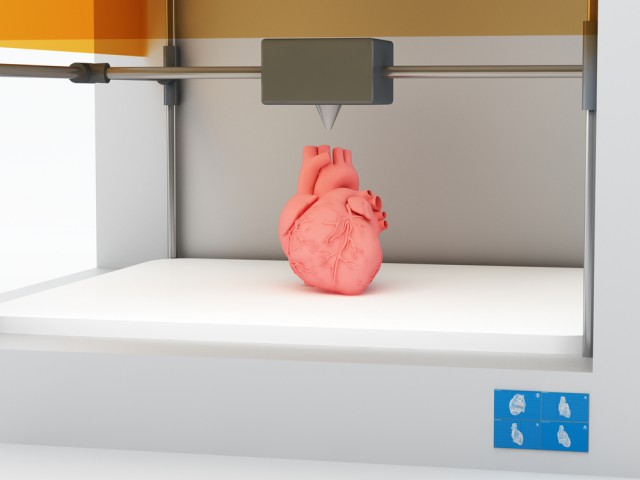5 industries being revolutionized by 3D Printing

Ever since its conception, 3D printing has represented a significant leap forward in technology. Granted, many people believe there was an excessive amount of hype around 3D printing when the tech first hit markets.
While there were some kinks to work out, however, no one can deny the revolution that swept over almost every industry in the world. The simple idea of creating anything from nearly any material in the comfort of your home or warehouse has meant that suddenly, a lot of middlemen are getting cut out of a job. Yet, for the businesses themselves, 3D printing has been a game-changer and a massive boon to their revenue. The technology managed to affect a lot of industries very differently, but here are a few of them.
1. Manufacturing
Manufacturing laborers used to create and build all the materials many businesses rely on worldwide. Now, 3D printing threatens to take over the manufacturing industry completely. However, the revolution is surprisingly slow and will take a lot more time. A few factors are preventing 3D printing from taking complete control.
The most significant issue holding 3D printing back is the time it takes to make a single part. While the process can be cheaper and easier, time is not precisely on the owner's side.
Plus, there are a lot of different techniques involved in manufacturing some industries may value over what 3D printing offers, which is building a single part over time instead of creating a large piece with many removable parts. Regardless, old-fashioned manufacturing is here to stay for the time being.
2. Health Care
Most people have already seen 3D-printed prosthetics, especially for children, who grow so fast. However, 3D printing is also helping health professionals replace other body parts, like organs, in emergencies.
Most people who picture 3D printing in action envision the machine using plastic. However, 3D printers can use almost any material, which is where health care starts getting creative. For instance, the FDA has approved the use of 3D-printed drugs in the United States.
Though this may sound unbelievable, there are two reasons. The initial hope is to encourage more kids to take their medicine by printing drugs that look like various cartoon characters. Secondly, and somewhat more groundbreaking, doctors will be able to prescribe precise doses of medication despite how much is available in the packets at the pharmacy, as well as preventing patients from cutting their pills.
3. Aerospace Technology and Space Travel
3D printing has revolutionized a lot of industries, but probably none more so than humans' pursuit of space exploration. The parts they require often cost millions to produce, not to mention the cost of sending them to the International Space Station. 3D printing could enable astronauts in space to print the parts they need on the station or shuttle without any hassle.
Even companies like SpaceX are throwing their hat into the aerospace technology ring, due in large part to 3D printing. If they could print the million- or billion-dollar parts necessary for a rocket that can breach the atmosphere, they wouldn't need government funding to get there.
4. Automotive
It's time to hark back to the original idea of manufacturing for a moment. Building the cars we eventually park in our driveways involves various parts from all over the world. Now, auto manufacturers can create many of these parts inside their warehouses, cutting down on exports, labor, material waste and time to save a lot of money.
Before, in the traditional ways of manufacturing these parts, about 60 to 70 percent of the materials became scrap, depending on what kind of part was involved. While using 3D printing, there is no more scrap. Manufacturers can reclaim, recycle and reuse the materials time after time. The value of saving raw materials alone creates more than enough revenue for the company to never regret owning a 3D printer.
5. Art
That's right, art. While housing, construction or any number of industries have come up in the 3D printing conversation before, the technology's reach is far broader than manufacturers. Commercial art is one of the industries where 3D printing is having an impact.
3D printing frees people from the easels, paints, chisels and raw materials traditionally involved in creating a physical artwork.
By sharing files, hundreds of people from various corners of the internet can collaborate on a piece of art that would otherwise seem impossible to create, not to mention objects for theater like armor-plated costumes, props and set design. 3D printing has opened a whole new view of art for the next generation to consume.
What Industries Are Next?
As mentioned, a massive drawback for 3D printing is the time required to print a single part or object. Even using multiple printers at once involves waiting on a finished product.
In the future, 3D printing is going to jump this hurdle, as well as the current limited use of materials. 3D printing has a chance of impacting every industry on the planet in the next few decades, so keeping an eye on the matter may be wise.
Photo Credit: belekekin/Shutterstock
 Kayla Matthews is a senior writer at MakeUseOf and a freelance writer for Digital Trends. To read more from Kayla, visit her website productivitybytes.com.
Kayla Matthews is a senior writer at MakeUseOf and a freelance writer for Digital Trends. To read more from Kayla, visit her website productivitybytes.com.
